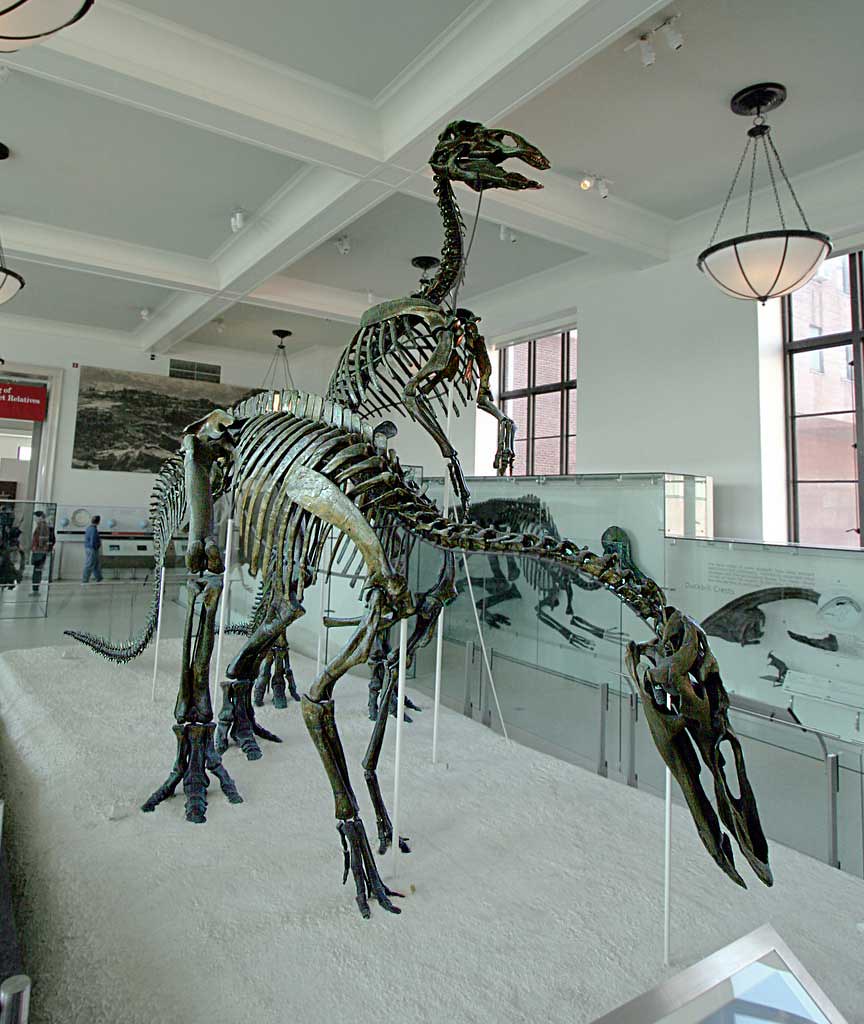#anatotitan
Text
Dinofact #109
Edmontosaurus' taxonomic history is quite complicated, with specimens belonging to E. annectens being classified as many other species, such as Hadrosaurus, Diclonius, and Claosaurus, as well as the dubious genera Trachodon and Thespesius, and, now synonymous with Edmontosaurus, the genera Anatosaurus and Anatotitan.
Source: Wikipedia
#dinosaur#dinosaurs#paleontology#edmontosaurus#edmontosaurus annectens#e. annectens#taxonomy#hadrosaurus#diclonius#claosaurus#trachodon#thespesius#anatosaurus#anatotitan#fun facts#trivia#dinosaur trivia#dinosaur fun facts#24th#december#2022#december 24th#december 2022#december 24th 2022
7 notes
·
View notes
Note
my partner and i have been arguing for the past 10 mins about how we know what dinosaurs looked like. they specifically have a problem with hadrosaurs and whenever i show them an up-to-date paleoart reconstruction of a hadrosaur (edmontosaurus and anatotitan were the big two) they just go ''they did NOT look like that. there's no way to know they looked like that.'' do u have any ideas how to explain the science behind reconstruction of extinct animals based on fossils? bc i'm at a loss lol
so we have tons of hadrosaur mummies, actually. so that's how for that one
other than that, we can extrapolate based on living animals. muscles scar the bones, so those are easy. organs typically go in similar places. and skin and feather impressions are helpful in many cases
but edmontosaurus straight up has a mummy, so we know exactly what it looked like
452 notes
·
View notes
Text
My big idea for Genie Team Season 10
Well, this is my 500th post, so I thought I’d talk about something big. That being one big idea I have for Grantgfan’s Genie Team season 10.
With that being the 10th season, I thought that my idea for it would be pretty big too. And my idea for The Genie Team season 10 is… the genies, their masters, and their friends finding out the realization of dinosaurs (and other prehistoric creatures) all around the world.
And this whole thing would be teased at the end of season 9, where a large map of the world with thumbtacks stuck in it, with each one depicting a known location of dinosaur sightings. They’d be 14 in all (at the moment); with 5 in North America, 3 in South America, 4 in Africa, 1 in Indonesia, and 1 in Australia. And as season 10 progresses, more thumbtacks would be added to the map, with a different color representing a different wave; like red for wave 1, blue for wave 2, green for wave 3, and yellow for wave 4.
And speaking of waves, the dinosaurs and other prehistoric creatures would make appearances in the several waves below.
WAVE 1: Dryosaurus, Gallimimus, Homalocephale, Kentrosaurus, Pachycephalosaurus, Styracosaurus, Ankylosaurus, Brachiosaurus, Camarasaurus, Corythosaurus, Edmontosaurus, Ouranosaurus, Parasaurolophus, Stegosaurus, Albertosaurus, Ceratosaurus, Dilophosaurus, Velociraptor, Acrocanthosaururs, Allosaurus, Spinosaurus, Tyrannosaurs Rex, Triceratops, Torosaurus, Carcharadontosaurus, Alioramus, Apatosaurus, Baryonyx, Compsognathus, Deinonychus, Diplodocus, Iguanodon, Maiasaura, Ornithomimus, Panoplosaurus, Tenontosaurus, Thescelosaurus, Wuerosaurus, Yangchuanosaurus, Pteranodon, Dimorphodon, Mosasaurus, and Tylosaurus.
WAVE 2: Othnielia, Hypsilophodon, Mamenchisaurus, Supersaurus, Brontosaurus, Ultrasaurus, Lambeosaurus, Shantungosaurus, Anatotitan, Olorotitan, Tsintaosaurus, Saurolophus, Hadrosaurus, Altirhinus, Centrosaurus, Einiosaurus, Pentaceratops, Euoplocephalus, Protoceratops, Psittacosaurus, Avaceratops, Microceratus, Orodrmeus, Gastonia, Edmontonia, Altirhinus, Brachylophosaurus, Gryposaurus, Hoplitosaurus, Stegoceras, Prenocephale, Tuojiangosaurus, Lexovisaurus, Paranthodon, Miragaia, Struthiomimus, Troodon, Proceratosaurus, Herrerasaurus, Torvosaurus, Tarbosaurus, Carnotaurus, Majungasaurus, Desplatosaurus, Suchomimus, Irritator, Procompsognathus, Ornitholestes, Cearadactylus, Geosternbergia, Nyctosaurus, Elasmosaurus, Plesiosaurus, and Styxosaurus.
WAVE 3: Dreadnoughtus, Alamosaurus, Argentinosaurus, Paralititan, Patagotitan, Sauroposeidon, Puertasaurus, Therizinosaurus, Convolosaurus, Leaellynasaurua, Stenopelix, Garudimimus, Wannanosaurus, Parkosaurus, Nipposaurus, Callovosaurus, Segnosaurus, Deinocheirus, Leptoceratops, Plateosaurus, Mussaurus, Melanosaurus, Oviraptor, Gigantoraptor, Caudipteryx, Lesothosaurus, Camptosaurus, Camposaurus, Yutyrannus, Rugops, Utahraptor, Dakotaraptor, Austroraptor, Sinosauropteryx, Mapusaurus, Tyrannotitan, Giganotosaurus, Gorogasaurus, Chirostenotes, Sinraptor, Microraptor, Sinornithosaurus, Archaeopteryx, Epidexipteryx, Caelestiventus, Tupuxuara, Zhenyuanopterus, Tropeognathus, Ornithocheirus, Hatzegopteryx, Alanqa, Hainosaurus, Icthyosaurus, Dakosaurus, Pliosaurus, and Temnodontasaurus.
WAVE 4: Shunosaurus, Saltasaurus, Nigersaurus, Amaragasaurus, Sinoceratops, Nasutoceratops, Agujaceratops, Chasmosaurus, Chungkingosaurus, Gigantspinosaurus, Dravidosaurus, Nodosaurus, Sauropelta, Minmi, Muttaburrasaurus, Dracorex, Stygimoloch, Dromiceimimus, Coelophysis, Eoraptor, Syntasaurus, Staurikosaurus, Saltopus, Shamosaurus, Struthiosaurus, Masiakasaurus, Eustreptospobdylus, Monolophosaurus, Limnoscelis, Labyrinthodontia, Diplocaulus, Koolosuchus, Metriorhynchus, Microposaurus, Sarcosuchus, Deinosuchus, Ichthyostega, Eogyrinus, Cacops, Seymouria, Prinoshuchus, Acanthostega, Eryops, Mastodonsaurus, Metoposaurus, Nothosaurus, Tanystropheus, Mesosaurus, Cryptoclidus, Kronosaurus, Liopleurodon, Shonisaurus, Onchopristus, Protostega, Archelon, Globidens, Ramphorhyncus, Ludodactylus, Scaphognathus, Tupandactylus, Azdarcho, Anomalocaris, Hallucigenia, Pterygotus, Ammonite, Cladoselache, Dunkleosteus, Eustenopteron, Hylonomus, Dimetrodon, Scutosaurus, Kannemeyeria, and Lystrosaurus.
That’s the four main waves of dinosaurs, pterosaurs, marine reptiles, and other prehistoric creatures that’ll appear in Genie Team season 10. It’s a lot of species, I know, but it’ll help in making season 10 of Grantgfan’s Genie Team even bigger. And I’d gladly help him in figuring out the scripts for future episodes of season 10.
2 notes
·
View notes
Note
Heya! Your recent dino etymology was super fun to read (≧▽≦)
I'll be really interested to read more of it :))
Also purely out of curiosity, but is there any story behind your knowledge of dino etymology?
I'm so glad you liked it! x) Here's another one:
So there is currently a dinosaur referred to as the Edmontosaurus, which means the not-so interesting "dinosaur from Edmonton," however, one of its earlier classifications was anatotitan, which much more interestingly means "giant duck." If I am being entirely honest, duck is not the first thing I would have likened to the pictures I've seen, but I guess with a layer of feathers it might make a little more sense.
The word is a compound in two parts, the first being the Latin anas which means "duck," and I've seen it be credited to a few different Indo-European roots, but the clearest connection looks like anat- for "duck" or "water bird." This particular root was what gave rise to the original Old English term for duck, ened, which was eventually replaced by a different Old English term duce, meaning "diver, dipper or ducker."
The second half is actually the same as one of the components of a previous dinosaur post, being titan which means "large, grand" coming from the Ancient Greek Τιτάν titan, which refers to the race of mythical, pre-Olympian giants.
To be honest, I'm not sure how I've learned so many of these. On more than one occasion I've fallen down an internet rabbit-hole finding increasingly bizarre names for sometimes otherwise innocuous or sometimes utterly entirely absurd creatures. Scientists are much more creative people than they get credit for.
#onelook.com#lexilogos.com#wiktionary.org#Charlton T. Lewis#An Elementary Dictionary at perseus.tufts.edu#etymonline.com#https://academiaprisca.org/indoeuropean.html#language#linguistics#etymology#history#dinosaurs#ducks#Old English#Latin#Proto-Indo-European#PIE#historical linguistics#philology#fun facts#words#animals#natural history#science#https://www.old-engli.sh/dictionary.php
7 notes
·
View notes
Text
Dinosaur Names You Can Use for a Pet
New Post has been published on https://www.petculiars.com/dinosaur-names-you-can-use-for-a-pet/
Dinosaur Names You Can Use for a Pet
Dinosaur names are very interesting and some of them do really well for some pet types. The lists I’ll be giving you below are of over 100 dinosaur names you can use for your pet, to make it stand out. The rest of the article will also have some tips you can use when picking out the perfect dino name for your pet depending on its character. You will get some ideas of real-life paleontologist-approved dinosaur names, dino-themed names, as well as cute and famous tv dinosaur nicknames. You will basically get a list of every type of dinosaur you might have heard of.
The Best 19 Dinosaur Names for Pets
I’ll first go over the list of the 19 dinosaur names for pets I like the most. You might recognize some of the names as coming from games, movies, or TV shows. There are also some that are simply based on the scientific name that a certain dinosaur type has received.
Arlo
Barney
Bowser
Bronty
Dino
DinoMighty
Dippy
Dorothy
Godzilla
Grimlock
Gronk
Horacio
Iggie
Reptar
Rex
Spike
Steggie
Sue
Yoshi
Some Cool Pet Dinosaur Names
Dinosaurs are very cool, and you can’t deny this. If you think that your pet is so awesome that it really deserves the name of a cool dinosaur, then check out the names from the list below.
You might also like my articles on pet names of the year, names for pairs of pets, or great mustang horse names.
Big Al
Chomp
Claw
Crackers
Dino Lord
Elvis
Fossil
Max
Megalith
Raptor Zord*
Roar
Scar
Snappy
Spike-a-saurus
Stegmutt
Stego Zord*
The King
Titano Zord*
Trike
Zeg
Zippo
Cute Dinosaur Names for Pets
If you have an adorable pet but still think that it might be appropriate to give it a dinosaur name, then go over this list of very cute puns and dino-related nicknames, which are perfect for lovable pets.
Barry
Brontosnorous
Bronty
CompsogNathan
Compy
Cute-a-saurus
Don
Eddie (coming from Edmontosaurus)
Feathers
Fluffasaur
Frill
Gertie
Little Liz
Paris-sauralophus
Rexie
Speedy
Spiny
Sweetiesaur
Tinydon
Toothless
The Real, Scientific Dinosaur Names, for Weirder Pet Owners
Do you have a pet that seems very clever? Is it the type of pet you really have to take seriously? Then you might consider that a proper name for it would be the real, scientific name of a dinosaur. Or if you want to keep things even cooler, just give the pet an English translation of the dino name.
Velociraptor
Tyrannosaurus Rex
Triceratops
Stegosaurus
Spinosaurus
Pterodactyl (Winged Fingers)
Protoceratops
Oviraptor (Egg Thief)
Mamenchisaurus
Maiasaura (Good Mother Lizard)
Iguanadon
Gigantosaurus
Gallimimus (Chicken Mimic)
Diplodocus
Camarasaurus
Brontosaurus (Thunder Lizard)
Brachiosaurus
Baryonyx (Heavy Claw)
Barosaurus
Apatosaurus
Anatotitan
Albertosaurus (Deceptive Lizard)
Dinosaur Names from Classic Kids’ TV
Are you the type of person that doesn’t like formal, serious names? Then let’s shift our attention to the more nostalgic world of Children’s TV, where you can actually find some very cool dinosaurs. Some of them might even revive some old memories of yours. Here is what I could find from three of the most known kid’s TV companies.
From Disney, the very popular classic by Jim Henson, ‘Dinosaurs’:
Charlene
Earl
Ethel
Mr. Lizard
Richfield
Robbie
Sinclair
The Baby
Let’s see some of the dino names from a more up-to-date TV show for kids, the ‘Dinotrux’ robo-dino series.
Click-clack
Dozer
D-structs
Reptool
Revvit
Scraptor
Skya
Ton-ton
Ty
What about the dino names from the animated film series ‘The Land Before Time’?
Cera
Chompy
Duckie
Littlefoot
Longneck
Petrie
Sharptooth
Names from the Jurassic World movie
Are you looking for dino names that sound a little more mature for your pet? Then what about dinosaur names you can get from movies? Or you can also pick a name of a famous director, actor, or even movie character from a famous movie with dinosaurs.
You can find quite a few options in the Jurassic Park/World movie franchise:
Alan
Attenborough
Blue
Bryce
Bumpy
Charlie
Chris
Crichton
Darius
Delta
Echo
Ellie
Hammond
Indominus
Indoraptor
Jeff
Laura
Macy
Malcolm
Owen
Pete
Sam
Spielberg
Tea
Vince
Or you might have a different dinosaur movie you like more. Try to watch it again and remember some of the names of the leading characters. Who knows? Maybe one of them will be perfect for your pet.
Real-Life Dinosaur Celebrities
Some people give their pet the name of a dinosaur straight up. But why not be a little more subtle when picking out a name? The names below are related to real celebrities in the dinosaur world. You will have examples of paleontologists that are behind some very amazing discoveries, but also presenters that made it so that kids love the prehistoric. All of them have their individual places in dinosaur history.
The list also contains the reason behind them becoming famous. Take a look and see if any one of them is appropriate for your pet.
Andy Day He presented the show ‘Andy’s Dinosaur Adventures’ Barnum Brown he discovered the T-Rex dinosaur Benjamin W Hawkins was the one to make the first dinosaur models Elizabeth Philpott Victorian paleontologist Jack Horner he was behind the discovery of the Maiasaurus’ nesting grounds Jack McIntosh one of the leading sauropod experts Joan Wiffen the first individual that found dinosaurs in New Zealand Karen Chin studied the first fossilized T-Rex dung Lawrence Lambe Canada’s first dino finds Luis Alvarez behind the meteorite theory of dinosaur mass extinction Mary Anning a Victorian expert in fossils Nigel Marven he was the presenter of the ‘Prehistoric Park’ Othniel Marsh named Triceratops and Stegosaurus Patricia Vicker-Rich one of the leading Australian paleontologists Richard Owen was the one that invented the name ‘dinosaur’ Roy C Andrews he was behind the discovery of the Velociraptor Ruth Mason he discovered thousands of fossils Stephen Fry He narrated the ‘March of the Dinosaurs’ Sue Hendrickson he found a T-Rex skeleton in South Dakota William Buckland he was behind the discovery of Megalosaurus William Parker Foulke he was the one to discover the first American dinosaur skeleton Zhao Xijin he named 17 dinosaur families and species
Finding The Best Dinosaur Name
When picking the best dinosaur pet name you can pick from a very wide range of different sources. From celebrity Victorian fossil searchers to names that reflect the looks of the dinosaurs, from real-life dino bones to fictional or cartoon dinosaurs, the possibilities are endless.
I hope the lists above will give you some ideas for great names for your pet. Don’t forget to go for one that is related to dinosaurs, while still reflecting the personality and looks of your pet, at least to some degree.
1 note
·
View note
Photo

The top is a sketch of the basic composition and the bottom two are the fleshed out poses of the characters. #edmontosaurus #hadrosaur #anatotitan #tyrannosaurus #tyrannosaurusrex #tyrannosaurid #tyrannosaur #dinosaur #dinosaurart #paleoart #paleontology #paleobiology #art #traditionalart #drawing #sketch #pencildrawing #doodle #portrait #animalportrait #animals #animalart #anatomy #animalanatomy #wildlife #photoshop #naturalhistory #naturalhistoryillustration #naturalhistoryart https://www.instagram.com/p/CAADbFulqI7/?igshid=16vbmh90e6tyr
#edmontosaurus#hadrosaur#anatotitan#tyrannosaurus#tyrannosaurusrex#tyrannosaurid#tyrannosaur#dinosaur#dinosaurart#paleoart#paleontology#paleobiology#art#traditionalart#drawing#sketch#pencildrawing#doodle#portrait#animalportrait#animals#animalart#anatomy#animalanatomy#wildlife#photoshop#naturalhistory#naturalhistoryillustration#naturalhistoryart
4 notes
·
View notes
Video
#Anatotitan#Dinosaur#Cretaceous#Mesozoic#Prehistoric#Extinct#Skeletons#AMNH#Museum#American Museum of Natural History
76 notes
·
View notes
Photo
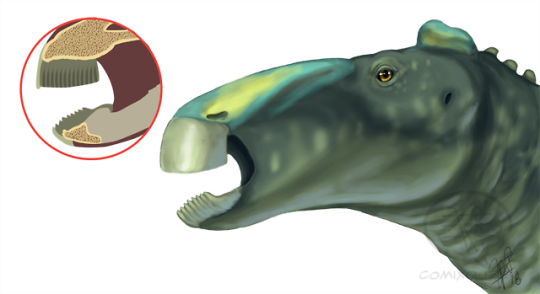
Finally posting this here; one of the finished pieces from my museum internship! This will debut at SVP this week on a poster about hadrosaur beaks! And what weird, weird beaks they had!
#science illustration#paleoart#palaeoart#edmontosaurus#edmontosaurus annectens#anatotitan#anatosaurus#art
355 notes
·
View notes
Photo





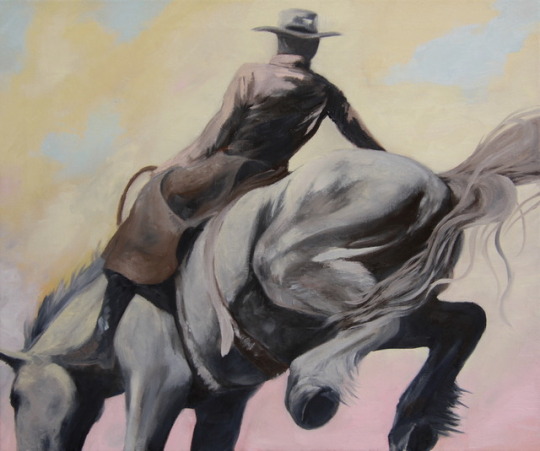
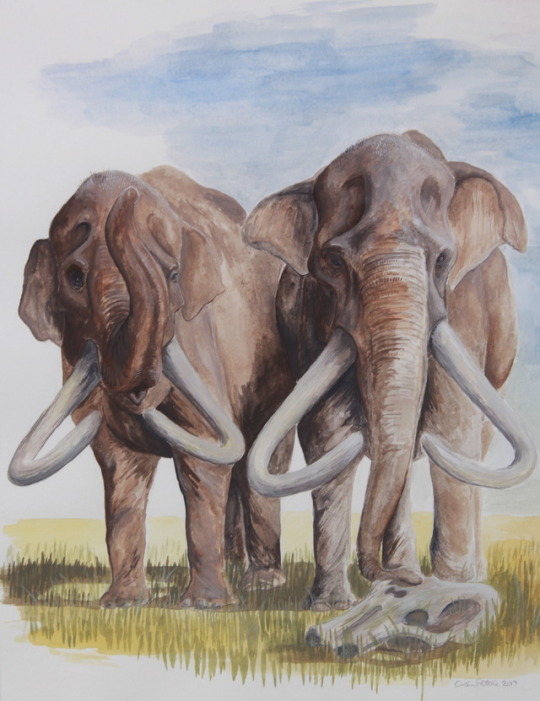



So my time at the Carter County Museum came to an end and I could not be happier with what a great experience it was! I finally got to see what being a paleoartist was like as well as getting up every day to go into the studio and paint every day. Thank you to all of my followers and your encouragement along the way!
#paleoart#paleontology#carter county museum#dinosaurs#mammoth#pterosaur#tyrannosaurus#anatotitan#triceratops#quetzalcoatlus#deinonychus#mosasaurus#pachycephalosaurus#ankylosaurus#oil painting#art#painting#scientific illustration#science
77 notes
·
View notes
Text
My dad brought me an early birthday present, which is great and I love it, however

The dinosaurs are horribly inaccurate, not to my surprise since it's so hard to find accurate things these days, but


The spinosaurus????? This is literally the weirdest and most far off spinosaurus interpretation I've literally ever seen, it doesn't even look like a spino it looks more like a ouranosaurus...
#also the pterodon. 'flying dinosaur' AUGH#the pronunciations they put near a lot of the dinosaurs are strange too??? parasaurolophus?? ol us phus?? its low fus#ALSO anatotitan isnt a dinosaur anymore I believe#it was removed and now its just an edmontosaurus I think#I was reading about it the other day but I forgot the full details
6 notes
·
View notes
Text
Tuesday 7/12/21 - Where are all the medium sized Theropods?

"The Horrors of Thieving", Allosaurus, Ornitholestes; FredtheDinosaurman (deviantart)
Ecosystems these days are made up of animals and plants of varying sizes and niches. Niche partitioning is a term used to describe how different roles in an ecosystem are taken up by different species. Carnivores for example, can be suited to a variety of roles, even within the same biological family.
Think of North American canines for example. Red Foxes are a smaller predator, hunting rodents, small birds etc. Then there's Coyotes who hunt those smaller prey too, but also hunt larger animals like beavers, and porcupines, and even pack hunt for animals like deer. Then there's Wolves, which may opportunistically scavenge, but are specialised in larger prey as a pack, like bison. Just like prey, predators can inhabit a small size, medium size, or large size niche. But this divide was long-thought to be seemingly absent in dinosaurs.

Red Fox (smallest), Coyote (middle), Grey Wolf (largest), National Parks Service
Ok so when you think of the size of a meat-eating dinosaur, you either think of a large apex predator like Tyrannosaurus or a smaller agile hunter like a Velociraptor. Late Mesozoic Theropods are consistently either huge, or man sized, and palaeontologists were puzzled as to why there were so few species in the middle. There were small, medium, and large prey animals in the age of reptiles, so why was there no medium sized theropods to fill in that niche?
Recently, there has been a revision on how we understand the growth and diet of predatory dinosaurs that may help to understand a solution to this question. Modern pack hunting animals share their kills with their family groups. An African Wild Dog puppy is not large or powerful enough to kill an Antelope, but a large portion of their diet will be Antelope because their parents will share the kill.
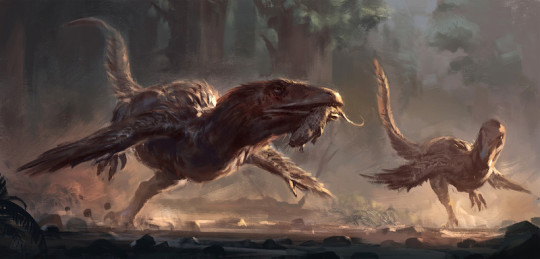
Deinonychus catch, Raph Herrera Lomotan
Studies of coprolites (fossil poo) and fossilised stomach remains in young dinosaurs have revealed it may have worked out differently. Young Deinonychus have been found to have different nutrients in their diets to adults, and palaeontolgists think this is because they hunted different animals (Frederick et al 2020). Adult Deinonychus had the power and skill to kill dinosaurs larger than themselves, but juveniles could not, so would've pursued smaller reptiles, mammals, or even invertebrates. Adults didn't share their kills with their young, so they had to find their own food.
This ontogenetic (relating to aging and development) variation in niches has also been theorised in larger theropods, to the point where some smaller to medium-sized dinosaur species have been identified as potential juveniles of larger species. Nanotyrannus was a species of smaller Tyrannosaur that has a very different body shape compared to the largest of the group. It had been described as about as tall as an adult human, with long slender legs, and had an extensive covering of feathers. But new studies have discussed the possibilities of Nanotyrannus being the juvenile form of Tyrannosaurus rex itself.
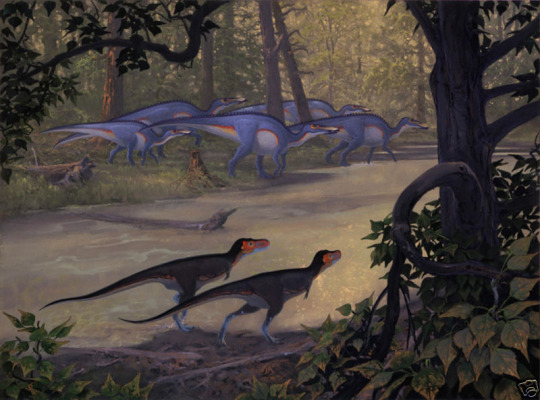
Nanotyrannus stalking Anatotitan, Doug Henderson
If this was the case, as many palaeontologists are on board with, it means that young Tyrannosauruses were specialised for a very different lifestyle than their adult counterparts. The juveniles were pursuit predators, running after smaller prey items, whereas the adults would take on larger dinosaurs, and did not have nearly enough leg strength to run for longer distances.
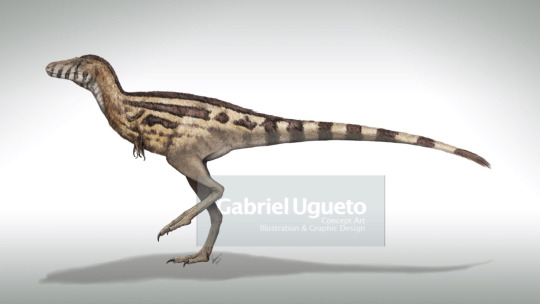
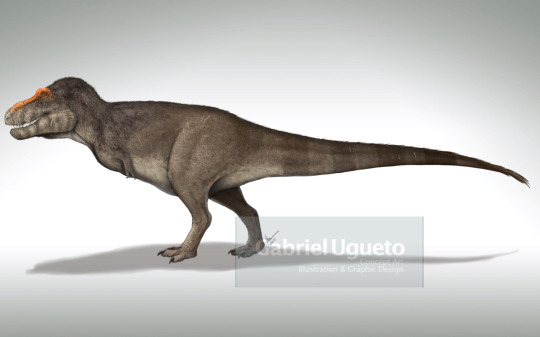
Juvenile/Adult Tyrannosaurus, Gabriel Ugueto
Scipionyx, the first dinosaur species discovered from Italy, has also theorised to be the juvenile of a larger species. It was initially classified as part of the group Compsagnathidae, but palaeontologists have begun to question whether the group itself is natural, or if scientists have just grouped together unrelated species of the same body shape and size. Given the shape and plasticity of its bones, the known specimen of Scipionyx is thought to be a hatchling, but a hatchling of what? Italian Paleaontologist Andre Cau theorised (Cau 2021 (its in Italian)) that Scipionyx was a juvenile Carcharadontosaurid, and further, that most of the Compsagnathid group consists of juveniles of large bodied theropods. The "Compsagnathid" body shape could in fact just be the body shape of juvenile Tetanurans (the clade including most theropods).
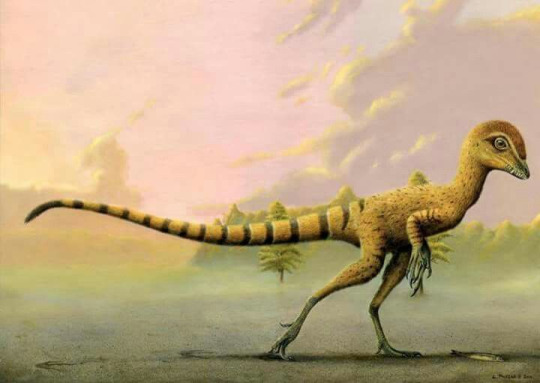
Scipionyx, Lukas Panzarin
This type of ontogenetic niche partitioning exists today in some reptile groups, particularly in Komodo Dragons, where the juveniles are aboreal insectivores, and the adults hunt mammals many times larger than themselves.

Juvenile Komodo Dragon, Mark Ralston
Dinosaurs were not mammals, and in fact are unlike many other groups alive today, and understanding their biology and behaviour requires looking into many different vertebrate groups. So, to answer the question posed by this post's title? Where are all the medium sized theropods? Its likely they're the bigger ones going through a phase.
Cheers for the read.
744 notes
·
View notes
Photo




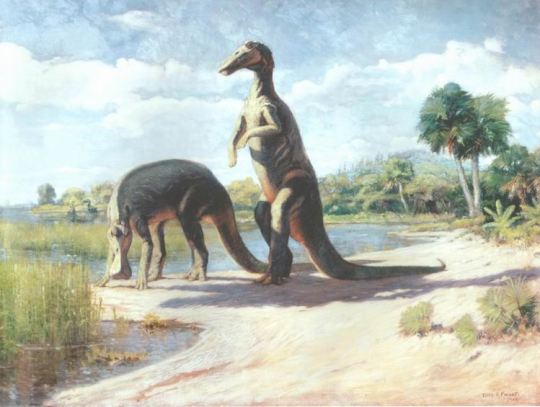





Charles R. Knight (American, 1874-1953)
Though his depictions of the postures of these ancient animals are now dated, Charles R. Knight’s portrayals of prehistoric creatures are fondly remembered as a child looking at the murals behind the skeletons in the museums.
Through his many sculptures, book illustrations and museum murals, Knight influenced the way generations of Americans perceived the ancient world.
Born in Brooklyn and educated at the Polytechnic Institute, Knight studied at the Metropolitan Museum of Art and the Art Students League before beginning a life-long career in the service of natural history. His mentor in paleontology was Edward Drinker Cope (1840-1897), Curator of Paleontology at The Academy of Natural Sciences, who helped Knight envision prehistoric creatures as living organisms with many of the same behaviors as their modern counterparts.
Brontosaurus (now known as Apatasaurus) - 1897
Leaping Laelaps - 1897
Agathaumus - 1897
Tylosaurus - 1899
Anatotitan - 1905
Elasmosaurus - 1909
Stegosaurus - 1912
Tyrannosaurus confronts a family of Triceratops - 1919
Nesting Protoceratops - 1925
T. Rex Confronts Triceratops - 1927

Charles R. Knight working on Stegosaurus in 1899
#art by others#other's artwork#painting#sculpture#Charles R. Knight#dinosaurs#marine reptiles#prehistoric
198 notes
·
View notes
Text
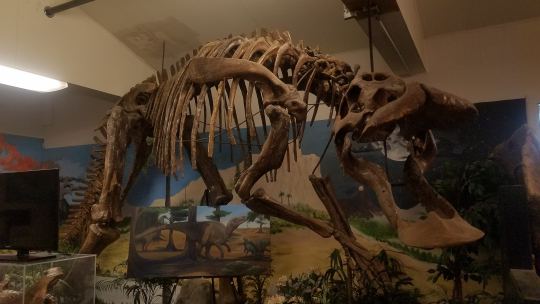

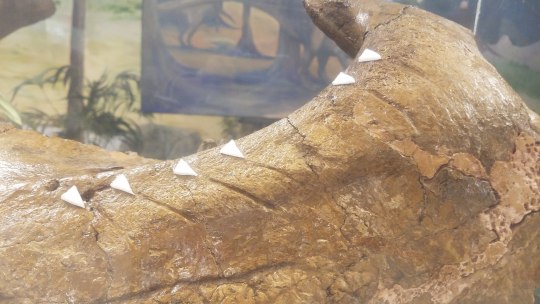


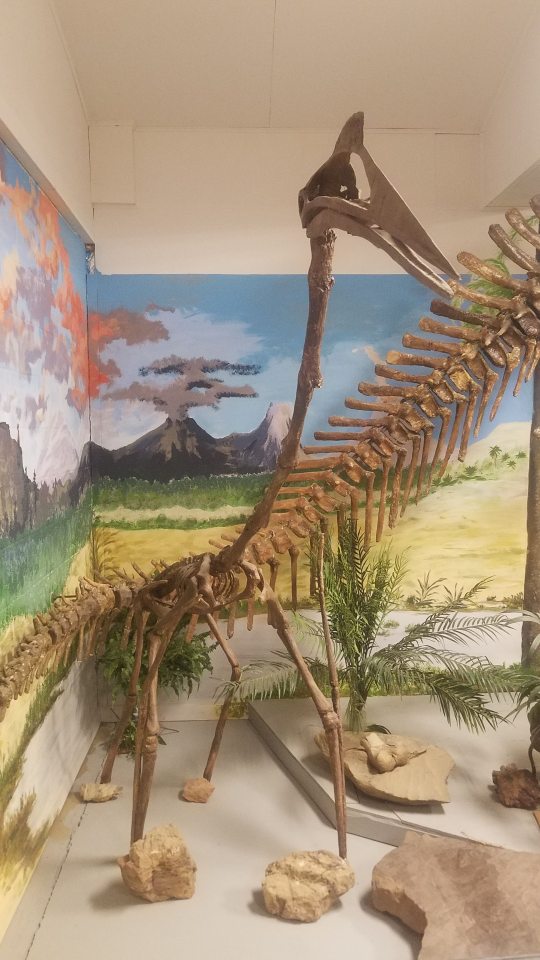

Carter County Museum Fossils.
From the top: Anatotitan, juvenile T. rex skulls, feeding marks from T. rex on a Triceratops jaw, the cast of the first pterosaur specimen in Germany, Elasmosaurus skull, Quetzalcoatalus, and the Wyrex Tyrannosaurus rex.
#carter county museum#paleontology#ekalaka montana#dinosaurs#hadrosaur#tyrannosaurus rex#t. rex#triceratops#pterosaurs#elasmosaurus#quetzalcoatalus#2021 ekalaka shindig
89 notes
·
View notes
Text
Dinosaurs
Looking back 65 millions years ago, but not necessarily to this day
Lived giant primordial lizards, imagine how many tons they must weigh
The terrible lizards that bring out childish glee
The mighty dinosaurs, rulers of the land and sea
We know of so many, their names fill us with wonder and dread
Like the mighty velociraptor, whose claws could rend and shred
Wait, no, that can’t be right, the velociraptor was very puny
To be trembling at the thought of them would be a little loony
But what about the tyrant king, the Tyrannosaurus rex
Well, he’d probably be covered in feathers, an idea that would perplex
What about the brontosaurus, the one with the long neck
Actually, they stuck a head on the wrong dinosaur and didn’t go back to check
What about the stegosaurs and ankylosaurus with armour all around
Well actually there aren’t many, because complete skeletons are never found
And these are just the dinosaurs you know
Have you ever stopped in a museum seen all the weird ones on show
Have you ever heard of the Anatotitan, whose name means giant duck
Or the gasosuraus whose name bring thoughts of flatulence, what terrible luck
What about the saltopus, minmi, shanag, or yinlong
What even is a Micropachycephalosaurus, surely a better name would come along
Or the one named by the irked researcher who named a dinosaur irritator to be prudent
Huh, you know that actually sounds like my average student
Dinosaurus are fantastic, and magical, and forever a wonder
Studying them is still a science, and will often come with a blunder
But I think it is still important to appreciate what they are
Parts of history, creation, imagination, and the bizarre
4 notes
·
View notes
Photo

Happy Birthday, Barnum Brown! Known as one of the greatest dinosaur collectors of all time, Barnum Brown helped the Museum establish its world-class fossil collection. Brown’s extraordinary fossil-hunting career—which took him from a frontier farm to the world’s top fossil sites and to the halls of the Museum—included the discovery of the first skeleton of Tyrannosaurus rex. Image no. 338624, AMNH Library, Barnum Brown with Anatotitan specimen collected by Edward Drinker Cope, American Museum of Natural History [1935-1950] (at American Museum of Natural History) https://www.instagram.com/p/B8e3N2VH-_Y/?igshid=f04d236id5zu
213 notes
·
View notes
Text
Update Time: Dinosaurs and Prehistoric Animals In Mass Media
A while back, I did a post on my findings for Dinosaur Representation in Film. Thanks to a project I’ve been aiding with, I’ve been able to greatly expand my media intact. From what I could watch (excluding the Simpsons, because how the hell am I gonna ID prehistoric life that cartoony), here are the top 10 prehistoric animals of various groups I’ve been able to log until about March of this year. Youtube always puts out something new, so I had to cut off some things.
This covers Movies, TV Shows, Educational Shorts, Direct to Video productions, Youtube Channels, and Youtube videos (for not largely dedicated prehistoric channels/playlists). This involved a lot of IDing I had to do myself. So when a documentary showed a mural or sculpture, I did my best to either deduce or track down the thing so I could ID things properly. Crystal Palace and Age of Reptiles showed up a LOT.
I even counted background skeletons for various museum shots when I could. Because I was going ALL IN on this.
And things that used 60% stock footage were not counted to avoid repetition. That said, footage from The Lost World (1925) got used a LOT, like, into the 21st century even!
As a final side note: SCREW Trilobites! They’re almost never IDed, and there are 40,000 of them!
Here is what I found out:
Top 15 Dinosaurs:
Tyrannosaurus - 306
“Raptor” (Velociraptor (90), Deinonychus (91), and Dakotaraptor/Giant Movie Villain Raptor (56) combined) - 237
Triceratops - 223
Apatosaurus ((121) and Brontosaurus(99)) - 220
Stegosaurus - 181
Allosaurus - 164
Basic Ornithomimidae (Struthiomimus (48), Ornithomimus (42), Gallimimus (30), Dromiceiomimus (8), Pelicanimimus (5), Archaeornithomimus (1) Combined) - 134
Edmontosaurus/Anatosaurus/Anatotitan - 124
Brachiosaurus - 121
Parasaurolophus - 121
Ankylosaurus - 97
Diplodicus/Seismosaurus - 93
Iguanodon - 82
Pachycephalosaurus ((56), Stygimoloch (15), Dracorex (8), and Alaskacephale (1) combined) - 80
Coelophysis - 73
Top 10 Birds/Stem Birds/Avilalans
Archaeopteryx - 84
Hesperornis - 26
Giant Moa - 23
Titanis walleri - 22
Ichthyornis (and related) - 21
Gastornis - 20
Phorurhacos - 18
Confuciusornis - 18
Teratornis - 17
Haast’s Eagle - 15
Top 10 Non-Avian Line Archosaurs
Crocodiles, Alligators, Caiman (Lumped Together) - 32
Postosuchus - 31
Sarcosuchus - 26
Desmatosuchus - 25
Deinoschus - 22
Smilosuchus - 17
Rutiodon - 17
Erythrosuchus - 17
Teleosaurus - 15
Tanystropheus - 15
Top 15 Prehistoric Mammals
Woolly Mammoth - 99
Smilodon - 83
Neanderthals - 73
“Cave Man (Cro-Magnon) - 64
Australopithecus - 59
Columbian Mammoth - 41
Equus ferrus (wild horse/tarpan) - 37
Mastodon - 37
Megalonyx - 37
Homo erectus - 36
Woolly Rhino - 36
Glyptodon - 33
Megatheirum - 32
Dire Wolf - 31
Gigantopithecus (including Kong and knockoffs of Kong) - 31
Top 10 Synapsids
Dimetrodon - 81
Edaphosaurus - 30
Inostrancevia/Giant Gorgonopsids - 28
Gorgonops - 25
Diictodon - 23
Placerias - 22
Lystrosaurus - 21
Moschops - 16
Lisowicia - 15
Tie: Estemmenosuchus, Secodontosaurus, Sphenacodon - 14
Top 10 Ancient Lepisosaurs
Mosasaurus - 66
Megalania - 30 (I lumped many a Slurpasaurus in here)
Tylosaurus - 30
Titanoboa - 17
Prognathodon - 14
Gigantophis - 9
Plioplatecarpus - 9
Platecarpus - 8
Dallasaurus - 7
Tetrapodphis - 7
Regular Iguana’s come in at #11.
Top 15 Pterosaurs
Pteranodon - 153
Quetzalcoatlus - 87
Rhamphorhynchus - 55
Pterodactylus - 45
Dimorphodon - 38
Ornithocheirus - 25
Geosternbergia (was once considered a species of Pteranodon, but they are easy enough to distinguish) - 24
Anuragnathus - 24
Hatzegopteryx - 22
Nyctosaurus - 16
Eudimorphodon also has a 16, but I flipped a coin for this list.
Top 10 Ichthyosaurs
Ichthyosaurus - 37
Ophthalmosaurus - 26
Temnodontosaurus - 19
Sonisaurus - 15
Mixosaurus - 13
Shastasaurus - 10
Cymbospondylus - 9
Eurhinosaurus - 7
Stenopterygius - 7
Cartorhynchus - 7
Top 10 Other Aquatic Reptiles
Elasmosaurus - 64
Plesiosaurus - 47
Nothosaurus/”Paleosaurus” - 24
Pliosaurus - 19
Kronosaurus - 18
Liopleurodon - 16
Placodus - 12
Dolichorhynchops - 10
Cryptoclidus - 8
Placochelys - 7
Top 5 Turtles
Archelon - 21
Megalocheluys atlas/Giant Tortoises - 11
Proganocheys - 10
Odontochelys - 7
Carbonemys - 6
Top 5 Primitive Reptiles
Scutosaurus - 26
Hylomnus - 21
Drepanosaurus - 14
Mesosaurus - 10
Sharovipteryx - 9
Top ~10 Prehistoric Amphibians
Eryops - 38
Ichthyostega - 32
Tiktaalik - 23
Mastodonsaurus - 19
Koolasuchus - 16
Seymouria - 16
Metoposaurus - 15
Prionosuchus - 14
Platyhystrix - 14
Diplocaulus - 14
Acanthostega - 14
Crassigyrinus is just short of being in the grouping.
Top 15 Fish and Sharks
Coelacanths (modern (23), Mawsonia (16), Coelacanthus (7), Rebellatrix (5), and Axelrodichthys (2)) - 53
Dunkleosteus - 32
Megalodon - 31
Lungfish (combined modern species and Necroceratodus) - 28
Xiphactinus - 26
Eusthenopteron - 26
Helicoprion - 24
Bothriolepis - 22
Onchopristis - 17
Orthacanthus - 17
Cretoxyrhina - 16
Hybodus - 16
Cheirolepis - 16
Cepjhalaspis - 15
Arandaspis - 14
Top 10 Arthropods & related.
Meganeura/Meganeuropsis - 59
Arthropleura - 27
Megalograptus - 26
Pterygotus - 24
Horeshoe Crab - 19
“Giant Spiders” - 18
Eurypterus - 18
Marella/Marellamorpha - 16
Pulmonoscorpius (Giant scorpion) - 14
Aysheaia - 12
Top 10 Trilobites
Generic Unnamed/Unidentified Trilobites - 38
Phacops - 24
REdlichia - 23
Isotelus rex - 20
Elrathia - 14
Dicranurus - 8
Asaphus - 8
Terataspis - 7
Olenoides - 7
Paradoxides - 7
If you don’t count the generic one, then the last slot is a tie for Harpes and Oryctocephalus (at 5 appearances each).
Top 10 Mollusks
Ammonite (Generic) (Identifying the various species of Ammonite by sight is as hard as the Trilobites) - 54
Cameroceras - 22
Belemnites - 20
Orthoceras - 16
Wiwazia 16
Nautilus - 15
Parapuzosia - 10
Clam - 10
Inoceramus - 9
Tusoteuthis/Giant Squid - 6
Top 9 Super-Primitive Basal Animals
Charnia - 20
Kimberella - 10
Dinomischus - 9
Amiskwia - 5
Ernietta - 5
Funisia - 5
Coronacollina - 4
Swartountia - 4
Cyclomedusa - 4
29 notes
·
View notes
